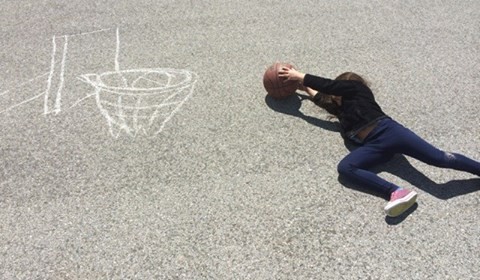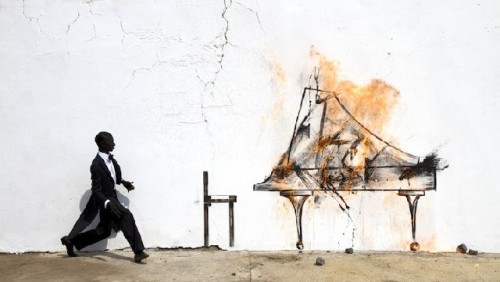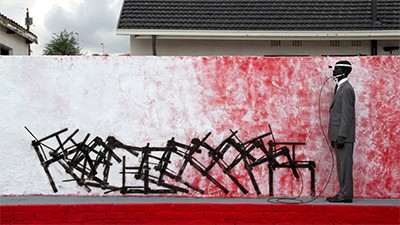Animating the Everyday by Robin Rhode
Winner of the Biannual Roy R. Neuberger Exhibition Prize
By: Edward Rubin - Aug 02, 2014
“I come from a culture that is very spontaneous, that has a lot of humor that has sarcasm. People can laugh at themselves quite easily. After going through such a horrendous political situation, they can still find humor in themselves. And I think a lot of my work stems from this South African mentality….It has to do with freedom, with the possibility of imagining or reinventing another world quite rapidly.” – Robin Rhode
The Neuberger Museum of Art in Purchase, New York, less than an hour north of New York City, is known for beautifully curated exhibitions, as well as intelligently timed choices. Always with ten fingers on the pulse of the art world – of hot-button subjects and important contemporary artists, both emerging and established. One of their most renowned, critic and crowd-attracting programs, named after the museum’s founder, is their Roy R. Neuberger Exhibition Prize. Given biannually, it celebrates early career artists, by giving them an exhibition accompanied by a fully illustrated catalog.
The museum’s current “must see” exhibition Animating The Everyday - running through August 10 – is a ten-year survey of the work of South African born, Berlin based artist Robin Rhode. Curated by Helaine Posner, the museum’s Chief Curator of Contemporary Art, along with co-curator Louise Yelin, the exhibition housed in two the museum’s largest galleries, using high definition projectors, and advanced musical composed sound tracks by Arenor Anuku, feature the artist’s digital animations, as well as a selection of his still photographs, the latter elegantly hung on charcoal gray walls.
Born in Cape Town, South Africa, in 1976, Rhode grew up in Johannesburg and came of age in South Africa as it was beginning its transition to democracy. Rhode is the third artist to be awarded the Neuberger prize. Previous recipients include Cuban installation and performance artist Tania Bruguera and American painter Dana Schutz.
Rhode’s work, sometimes performed, especially in his earliest works, by himself, addresses the complexities of life in post–apartheid South Africa. Created on the ground in the streets, against walls, and at his parents’ yard in Johannesburg, and at his Berlin studio where he now lives, Rhode’s videos, transform the quotidian into the playful and fantastic while still maintaining an underpinning of melancholy, danger, and risk. They are an uncanny conjunction of the familiar and the strange.
“I embrace chaos. I don’t create a work only with the idea that it has to be lighthearted; there’s something dark underneath." Still, as Rhode explained during a recent visit to the Neuberger, “Approachability and accessibility are fundamental to my work.
“I was in high school in the early 1990s, a volatile period before the first democratic election, before Nelson Mandela became president. I remember moments when teachers stopped teaching for weeks. This period was referred to as a ‘Chalk Down.’ School was basically closed, and we were let loose, [to roam] the streets... We stole chalk from the classroom, drew objects on the walls, and made the [younger] kids interact with objects, as if the objects were real.” It was through art school that he formalized those experiences and assimilated them into his work.
“You take material and change it into something else,” he said. “You steal the chalk used for educating, and use it to draw illegally on the concrete walls of the toilet. The subcultural language changes the meaning of the chalk. We drew the bicycle because we couldn’t afford to own bikes. You didn’t go to school with a bicycle, you never saw it, and so it became an extension of a desire."
The bicycle appears frequently in Rhode’s work both because it was strange and because it was familiar. Strange: “I have never,” Rhode says, “seen a pupil arrive at school by bike. So I thought that maybe the bike drawn on the toilet wall reflected the dimension of desire, of almost attaining that freedom, that sense of ownership.” Familiar: “I discovered that my learned experience could become a starting point of this artistic form.”
Rhode’s also recalls, as Yellen mentions in her catalog essay, the bike that he left behind in Cape Town when his family moved to Johannesburg, the racial history of South Africa, and the fact that during World War II, South African soldiers returning from the front were compensated according to race: white soldiers were given land; non-white soldiers were given bicycles. As a result, bikes play an important part in Rhode’s work.
In 'New Kids on the Bike" (2002), as well as other analogous works like "Horse" (2002) and "See/Saw" (2002) – children, holding on for dear life, are presented reveling in potentially death-defying calisthenics that threaten to ricochet them right off the page. Thereby emphasizing his work’s structuring tension between movement and stasis. These performative exertions reveal the operative dynamic of Rhode’s work as a tussle between the lure of being “anchored”–or grounded–and the “dreamscape” of weightless, gravity defying, motion.
These animations were shot in Rhode’s parents’ Johannesburg yard with children from the neighborhood who assumed a sequence of poses on the ground as Rhode photographed them with an overhead camera. Accompanied by soundtracks that intensify the viewing experience, they highlight the power of the imagination, yet flirt with danger even as they revel in the pleasures of play.
"New Kids on a Bike" (2002) is accompanied by a soundtrack composed of electronic samples. As a portrayal of schoolchildren “interacting” with bicycles drawn in chalk the kids, as they desperately hold onto the bicycle’s bars appear to be flying. Presenting children seemingly untethered by gravity and, therefore, occupying an enchanted world, "New Kids" looks back to the genealogy of cinema in magic shows and other attractions.
In 2005, Rhode created a pair of digital animations, "Untitled (Spade for Spade)" and "Harvest" in which he becomes a sower in an urban setting. Spraying white paint against a black wall, the artist sows a bag of seeds and waters them as we watch them grow into the long, flowing grasses of "Harvest." He goes on to vigorously scythe them down and build a bed from the harvested plants, finally covering himself with a real white sheet as he rests from his labors. According to critic Carol Kino, Rhode “seems to address metamorphoses and regeneration” in this dreamlike work, providing an apt metaphor for the major social changes taking place in post-apartheid South Africa.
In "Parabolic Bike" (2010), Rhode returns to the bike. Here a young girl rides a bicycle on an apparently perilous course, up and down steep inclines. Also shot from above, Parabolic epitomizes this destabilizing of ground. In an unusual framing of the cement yard, an L–shaped shadow paints not only the customary grounding horizontal at the base of the frame but also delineates a left margin that vies with it in an alternative perspective. Rhode complicates his bicycle’s standard trajectory by employing an actual rather than a chalk-drawn bicycle as a prop, and cycling it along an imaginary floor that snakes across each frame. Concretizing the unsteadiness implied in his early bikes as a testing of ground "Parabolic Bike" dramatically shakes up the horizontal plane, careening the cyclist across the yard.
"Chairs" also pervade his work. Between 2010 and 2011, Rhode produced a series of six video animations that took as their point of departure chairs created by Dutch furniture designer and architect Gerrit Rietveld (1888–1964). Composed mostly of vertical and horizontal planes and painted in the primary colors of red, blue, and yellow as well as black and white, Rietveld’s de Stijl designs recall the pure abstractions of painter Piet Mondrian, a contemporary. Although intended for the mass market, Rietveld’s chairs have always been more than everyday objects; they represent the ideals of modernist form and structure that Rhode cleverly co-opts and subverts, casting them as the protagonists in spirited scenarios that range from the playful, to dark and violent. In this group of animations, collectively titled “Variants,” Rhode introduced new elements of narrative, psychology, and the absurd to his work.
In "Arm Chair" (2011), moving from children’s games and activities, we encounter a mysterious male figure in blackface. Impeccably dressed in a grey suit, white shirt, and black tie, he appears before a scumbled surface of a deep red wall like an apparition, neatly dividing the frame of "Arm Chair" into two. The motionless young man slowly reappears, his eyes closed, wearing bizarre apparatus comprised of metal bands, wires, and tubes on his head. This device, called a phonoscope and invented in the 1920s, was used to measure the phonetic waves of the voice. (Though the only word heard on this track is the whispered “chair.”) The tubes twisting from this apparatus connect to a drawing of Rietveld’s famous "Red and Blue Chair" (1917) stenciled multiple times in black as it tumbles gracefully across the mottled red wall. Although this scene defies reason, it compels our attention.
"Piano Chair" (2011) perhaps the most powerful work in the exhibition, finds the artist entering darker waters. Here a young man in blackface, stylishly dressed in tailcoat and bow tie, facing a chalk-drawn piano on the wall, leaps into action. In this animation Rhode’s shadow self and a drawing of Rietveld’s 1923 piano stool become partners in crime as they carry out the “murder” of a baby grand. The character begins by throwing stones at the piano, then proceeds to attack it with a machete and an ax, smother it with a pillow, and douse it in gasoline and set it aflame, ultimately hanging it with a noose while kicking away the chair.
These exploits are punctuated by the staccato sound of piano notes and chords. Though absurd on its face, these acts echo the violence that infects life in South Africa, presented by Rhodes in aesthetic terms, as his dapper doppelganger visits street crime on a classical instrument. As Rhode explains, “The idea of the doppelganger or alter-ego, a ploy used extensively by Marcel Duchamp in his female character Rrose Sélavy, confronts the artist with his shadow self."
Rhode’s inspiration for "Piano Chair" is South African pianist and composer Moses Molelekwa, whose jazz compositions synthesized African and Western music, in both traditional and contemporary forms. Molelekwa, who grew up in a township outside Johannesburg, was widely known as “the brightest hope for a renaissance of South Africa’s jazz culture” as well as a producer of kwaito music, a popular urban style blending garage, Indian raga, and hip-hop music with the sound of township jive.” In 2001 the musician was found hanged at age twenty-seven next to his wife’s body in their office in downtown Johannesburg.
"Piano Chair" is Rhode’s homage to Molelekwa, an accomplished artist of his generation, whose inventive mix of cultural idioms mirrors his own. The video, staged against an anonymous white wall in the western part of Johannesburg, a place known for serious criminal activity during the apartheid era and beyond, is shrouded in violence. It is shot on the streets under potentially dangerous circumstances and depicts violent acts. At the same time, as curator Posner notes, “the work is choreographed and performed with elegance and more than a touch of wit as life becomes the stuff of art.” Coincidentally (or not) Rhode moved to Berlin the next year.
"Open Court" (2012), made in Berlin, reveals many of the important features of Robin Rhode’s work: It is witty. It is playful. It makes use of ordinary things. And it participates in Rhode’s ongoing conversation with his artistic precursors while demonstrating his repurposing of their work in his own. Here, a man with a racket – the artist himself -- is hitting a ball against a wall. What we first take to be a wall is not a wall; it is a well-known Richard Serra work titled "Berlin Junction" (1987). The ball is not a ball; it is a succession of snowballs. The marks left by the snowballs deface Serra’s monumental sculpture and call into question the modernism that Serra exemplifies.
Rhode, as part of the first post-apartheid generation to experience the effects of globalization and to embrace such American influences as hip-hop and graffiti, basketball, advertising and the movies, is interested in creating a bridge between his experience in South Africa with various movements in European and American modern and contemporary art. As Posner writes, “Rhodes refashions artistic precursors and contemporaries such as Marcel Duchamp, Gerrit Rietveld, Mies van der Rohe, William Kentridge, and Richard Serra."
“As much as Rhode’s animations delight and entertain, celebrate and demonstrate the triumph of the imagination,” as catalog essayist Tom Gunning reminds us “they also bring us down to the ground. Animation brings things to life, but not in the work of the most powerful experimental animators, from Émile Cohl to Len Lyr and Norman McLaren, Harry Smith to contemporaries like Lewis Klahr, Janie Geiser, and Jodie Mack, we never lose the sense that the magic of transformation is founded in the labor of the hand in relation to the technology of the camera.
Handwork is hard work. The work of dreams and imagination rests on the ground of reality and the surface of things. If the progressive arc of Rhode’s work seems to darken and dwells increasingly in the world of adult limitations, standing on its own two feet within a shallow space, nonetheless the work of transformation remains possible. Animation projects into a future, imagines a trajectory of movement not yet completed. But as Rhode’s teaches us, it also leaves a trace of the past, the wake of memory, as we strive to find some way out of the contours, some way to lift off the surface.
Video # 1 The artist’s first solo exhibition in a U.S, Museum the Wexner Center for f the Arts, Columbus, Ohio. Organized by Senior Curator Catharina Manchanda—brings you a firsthand look at his intriguing work. Thu, Apr 2 - Sun, July 26, 2009.
http://youtu.be/9cVHtwuAm0E
Video # 2. Published on Dec 5, 2012
Famed for his trailblazing fusion of street and performance art, South African artist Robin Rhode has collaborated with The Vinyl Factory to release his first vinyl record - the soundtrack to a series of six short films originally produced for his show at White Cube. A hand stenciled and signed limited edition of 100 copies, pressed on pristine 12" white vinyl, this edition are available to pre-order now, exclusively from The Vinyl Factory.
http://youtu.be/kKnBqhD2g1M
A fully-illustrated catalogue accompanies the exhibition. It contains essays by co-curators Helaine Posner, Senior Curator of Contemporary Art, Neuberger Museum of Art, and Louise Yelin, Professor of Literature, Purchase College; Tom Gunning, Edwin A. and Betty L. Bergman Distinguished Service Professor, Department of Art History, Department of Cinema and Media Studies, and the College at the University of Chicago; and Leora Maltz-Leca, Assistant Professor of Contemporary Art in the Department of the History of Art and Visual Culture at the Rhode Island School of Design accompanies the exhibition
----
The Museum is located at 735 Anderson Hill Road in Purchase, New York (Westchester). 914-251-6100 www.neuberger.org
Museum Hours
Tuesday through Sunday, 12 noon to 5 pm, Closed Mondays and major holidays
Admission
$5.00 General Public, $3.00 Seniors, Free admission for Museum members, children 12 and under, and Purchase College students, faculty, and staff
Credits for Robin Rhode images Courtesy of the artist and Lehmann Maupin, New York, Hong Kong © Robin Rhode.







